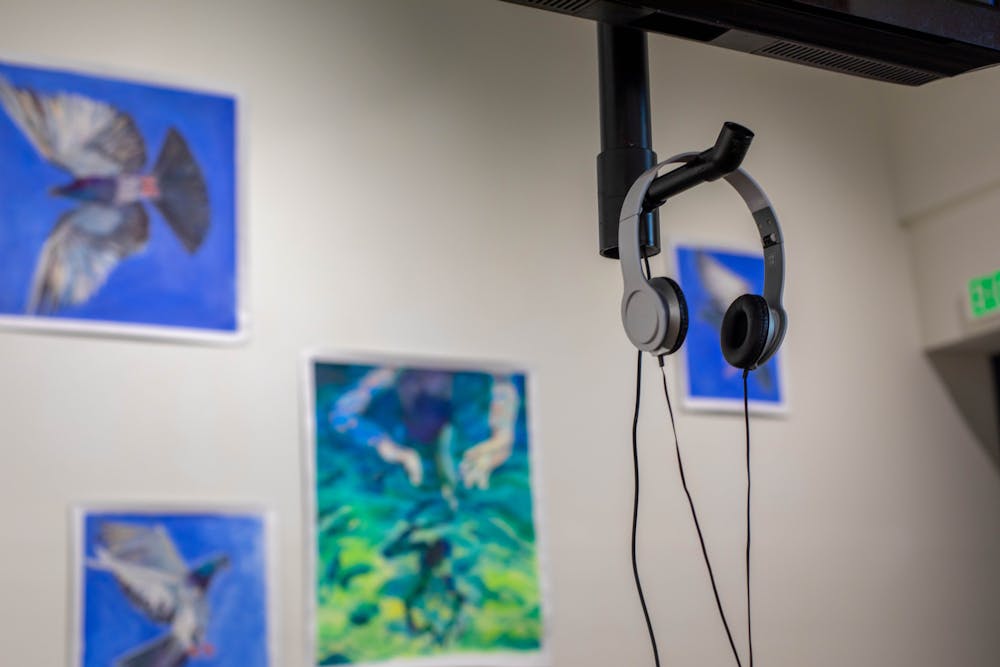Artwork made of artwork, a collage of pieces saved by Asst. Prof. Elizabeth Schoyer lines a wall of Ruffin Gallery floor to ceiling in “Murmuration,” a culmination of the connections formed between Schoyer and her students over the past 20 years.
Schoyer’s recent exhibition, “Murmuration,” which runs until Oct. 6, is comprised entirely of artwork by her former students and colleagues. The collage to the left upon the entrance features saved pieces from students over the years, which Schoyer said spans over about 20 years. According to Schoyer, the success of her students is central to her work.
Murmuration is a word with two meanings — both the quiet utterance of a noise and the name for a flock of starlings. The exhibition highlights how different voices flock together to form a murmuration. For Schoyer, the exhibition is her personal murmuration. She brings together all of these artists’ energies and influences as a narrative of the people she knows.
Schoyer features nine former students and three colleagues more in depth, putting two of each of their pieces — spanning topics from the environment to politics — on display around the gallery.
Rachel Lane, class of 2013 alumna and a Charlottesville-based artist, has two artistic short films on display.
“One requirement for all studio art majors was to take two semesters of drawing, and [Schoyer] was my professor for one of those semesters, and we just stayed friends ever since,” Lane said.
Lane’s two films, which play on a screen in the center of the room, both center around nature. According to Lane, the first piece is a work in progress, a documentary-style short film about a historic tree near the Charlottesville airport.
“I think the estimate is anywhere from 450 to 490 years old,” Lane said. “I'm in the early stages of creating this documentary film,” Lane said. “[‘Murmuration’] inspired me to begin… I've already met so many people who love the tree and have so much to say about it, and stories about it.”
Lane still feels Schoyer’s impact on her current art, though it has been 10 years since she was a student.
“These are brand new films… but I'm sure in many ways they are impacted by what I learned from her when I was her student 10 years ago, and I'm sure there are little traces of her presence in everyone's work,” Lane said.
Lane currently teaches art in the Charlottesville community to over 1,000 students every year, ranging from children to adults.
Sandy Williams IV, a current assistant professor at the University of Richmond and former student of Schoyer’s, brings two renowned pieces to the show, also through unconventional media.
Their first piece, “The (Bronze) Wax Monuments” is a collection of melted candles shaped like statues of former historical figures and Confederate generals — including a Robert E. Lee Statue that was recently removed in Charlottesville. They were driven to create them based on their time as a student at the University and in graduate school at Virginia Commonwealth University.
“I felt like [the wax monuments] were these little anti-monuments… they're miniature,” Williams said. “They're malleable. They're ephemeral and you can hold them and have agency over them.”
Williams said that they felt frustration about the cities’ failure to remove the life-sized Confederate statues and how it spurred them to create these pieces.
“I've been in Virginia all my life, and I've been around things that resemble or remember or commemorate the Confederacy,” Williams said. “So it was just this conversation that was unavoidable.”
Their other piece, a part of their “Unattended Baggage Series”, is an unconventional clear suitcase with a timer on it displaying how long since the piece has been touched.
“Violence exists invisibly in our spaces,” Williams said. “These backpacks also are occupying space, but in a different way, in a more suspicious manner, by their presentation, by the context of being in space.”
Williams said that Schoyer’s class left an impact on them — they did not originally intend to major in art. Williams found the small class to be a refreshing break from large lectures.
“[She] really cared about me and my story, and was helping me process that through art… and encouraged me to take more classes in film and sculpture,” Williams said. “Professor Shoyer was a big light in my life in my undergrad years.”
Schoyer requires her current Drawing students to interact with the exhibition as part of their course. They are required to draw response pieces, and, for extra credit, Schoyer offers Zoom meetings with the featured artists. This interaction displays the multigenerational span of students Schoyer has taught and impacted.
On the flier for “Murmuration,” next to the list of featured artists, there is a quote by researcher Andrea Cavagna, who comments on the nature of starlings.
“The [starling] group responds as one… cannot be divided into independent subparts,” the quote reads.
Schoyer’s “Murmuration” describes this phenomenon — a group of individuals, and unique artistic voices, make up a whole. The many voices are the culmination of Schoyer’s impact as a mentor, colleague and artist.
“[‘Murmuration’ is] a representation of Professor Schroyer's career and all the people that she's impacted and had relationships with,” Lane said. “It's very special what it represents. And I think it's a lovely gesture instead of putting her own work in the gallery.”
“Murmuration” is on display in Ruffin Gallery until Oct. 6 — Monday through Friday from 9 a.m. to 5 p.m.







